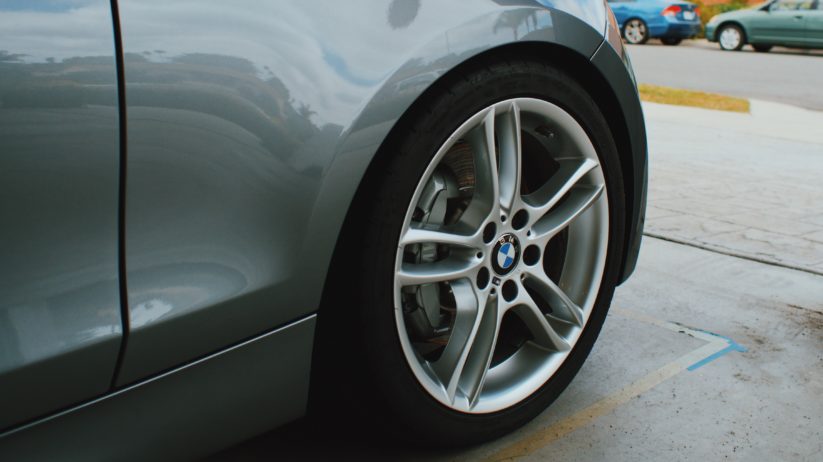BMW light-alloy wheels have a certain radiant presence to me when they are clean. Unfortunately, if you’re using the factory brake-pad compound, or one of the many comparable alternatives out there, the only time the wheels are clean is immediately after a wash. Once you’ve cut through the dealer’s grease and gotten down to the finish, which is BMW’s classic light silver—Reflex Silver, code A44—in my case, there is a certain something that causes the wheels to pop no matter the lighting. BMW has also added a number of other color and wheel finishes to its offerings, like Ferric Grey (code B55), which is seen on M-Sport models like the M235i, and Cerium Grey, the newest addition, but none of them have the same eye-catching presence when they are clean in comparison with the classic finish—if you ask me, anyway.
Anecdotal details aside, it only takes one drive or commute for a nice layer of brake dust to accumulate. I keep my 1 Series clean, as the photos of this article will demonstrate, but the M double-spoke light-alloy wheels have already accumulated a healthy coating of brake dust and road grime in the shot below.

From a distance, the wheel pictured above looks clean, but it’s wearing a nice blanket of brake dust. In the photo below, some of the accumulation becomes a bit more evident.
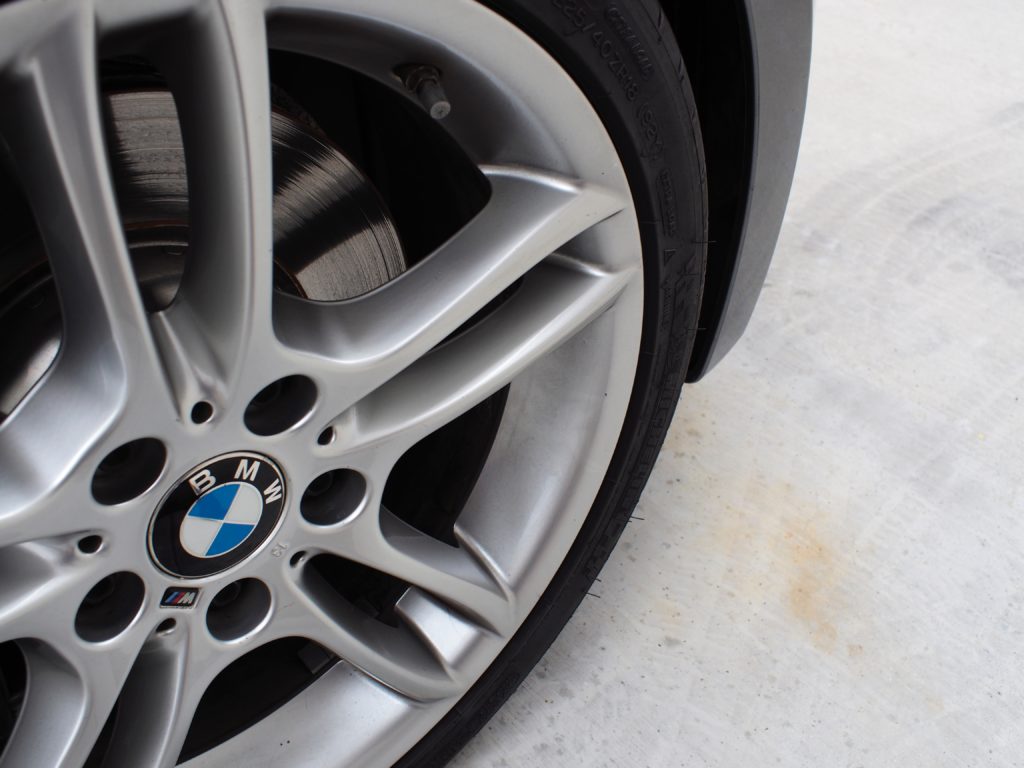
I will admit that I’ve let my wheels—of other previous BMWs—get much dirtier over the years, to the point where some minor yet irreversible pitting of the finish has occurred. The subject wheel doesn’t have too much dirt on it, but a quick swipe reveals that the paint is being masked by a dull film of brake dust.
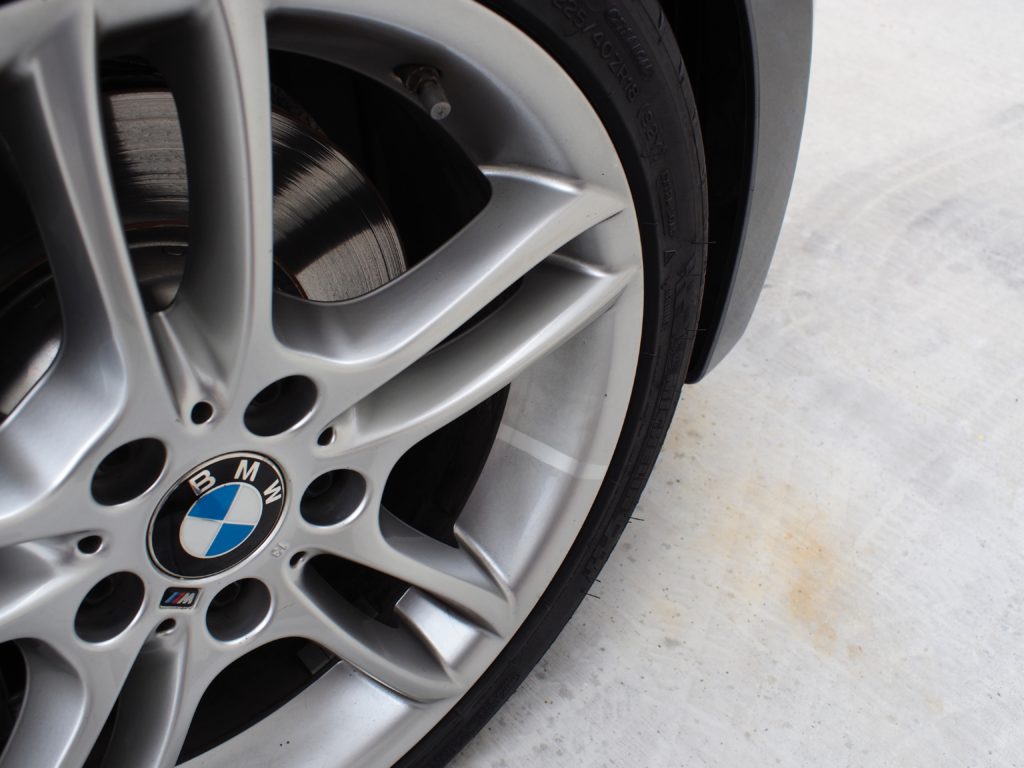
A brief swipe with a gloved finger reveals the true state of things.
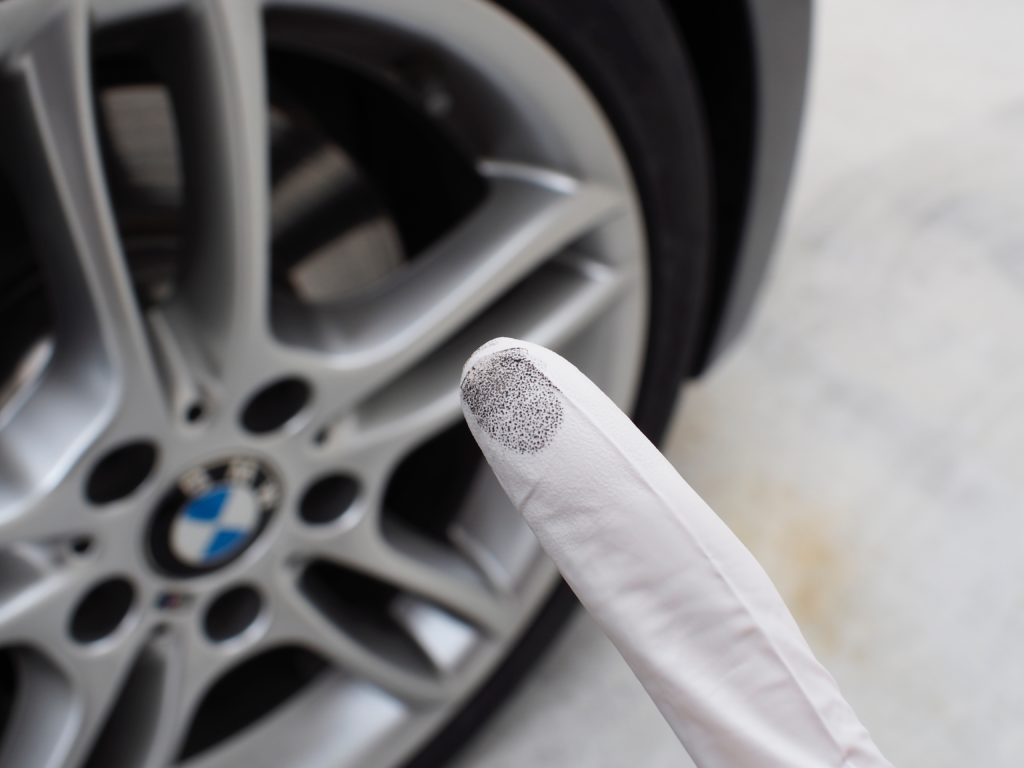
This is where BMW CCA sponsor Griot’s Garage enters the equation. As a long-term BMW enthusiast, I spent years and ruined a few wheel finishes trying to find a practical cleaner that could cut through the dust on its own, without me having to perform time-consuming scrubbing in the process. Those with even a slight interest in automotive detailing will recall that roughly a decade ago, color-changing, iron-particle-dissolving wheel cleaners took the world by storm. The most popular and the original as far as many are concerned is Sonax Full Effect Wheel Cleaner, which is manufactured by the same company that supplies BMW with its official, licensed car-care products.
Today, however, there are a number of competitors on the market. Sonax remains very popular, but is among the most expensive out there. For years before I found Griot’s Garage Heavy-Duty Wheel Cleaner—and before Griot’s ever graciously sent me their products to evaluate—I would seek out bulk deals for Full Effect, and then quickly burn through the lot while maintaining an ever-changing fleet of BMWs.
This all changed when I finally decided to buy Griot’s Garage Heavy Duty Wheel Cleaner, which I should have been doing the entire time, thanks to what I consider to be an industry-leading value proposition. Griot’s Heavy-Duty Wheel Cleaner exhibits the same color-changing properties as other competitors, cleans just as well, if not better, and sells in a 35-ounce bottle (my preferred size over the eighteen-ounce) for $21.99. Compare that to a 16.9-ounce bottle of Sonax, which will cost you $15.99 at a minimum.
Griot’s Garage also offers a full suite of wheel cleaning tools, in addition to a more mild cleaner, but if you drive a BMW with factory brake pads, Griot’s website specifically says that the heavy-duty stuff is for you.
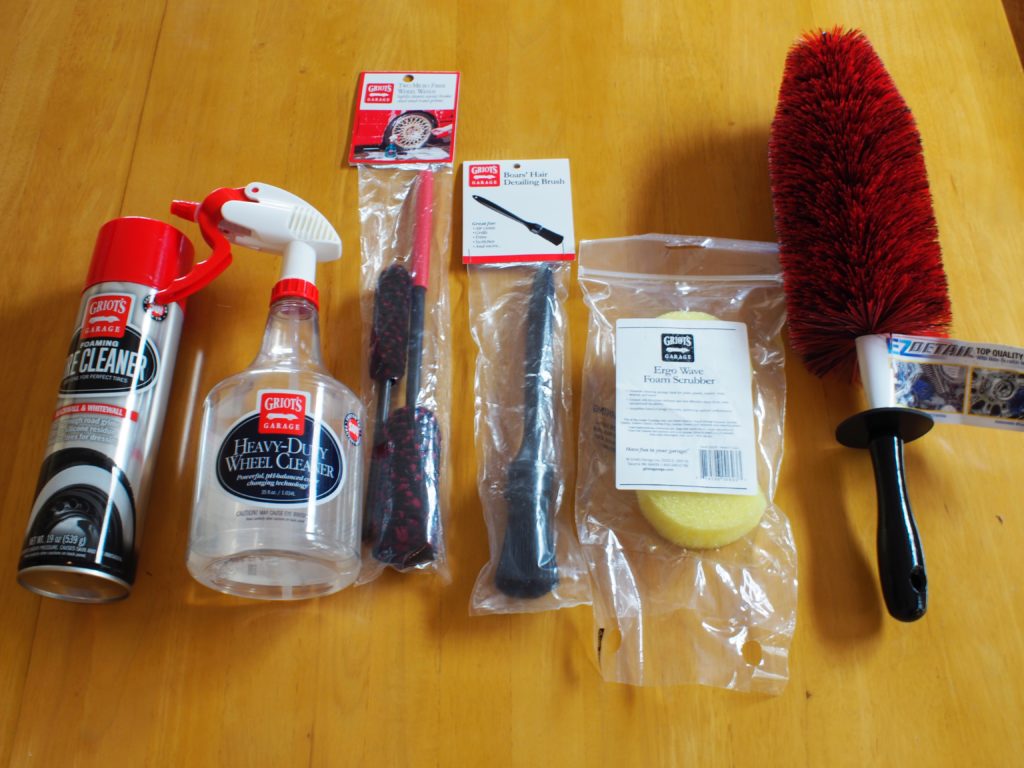
The process for using the wheel cleaner is a simple one, but with a few caveats. The first is application; Griot’s instructions say to hose your wheels down beforehand, just like the directions for other comparable wheel cleaners, but I have found that this step severely limits the cleaning power of the formula, thanks a layer of water that is left clinging the wheels. (And where I live, we look for ways to avoid wasting water!)
Instead, I start with a cool, dry wheel and apply a liberal coating of wheel cleaner. Griot’s Garage Finest Sprayer is a key component of this step in the procedure, as I adjust the nozzle to a specific point, which allows the wheel cleaner to exhibit a foaming action as it is applied to the wheels. This allows for the best coverage, in my opinion, and also avoids wasting the precious liquid with errant shots that land on the brake rotors instead.
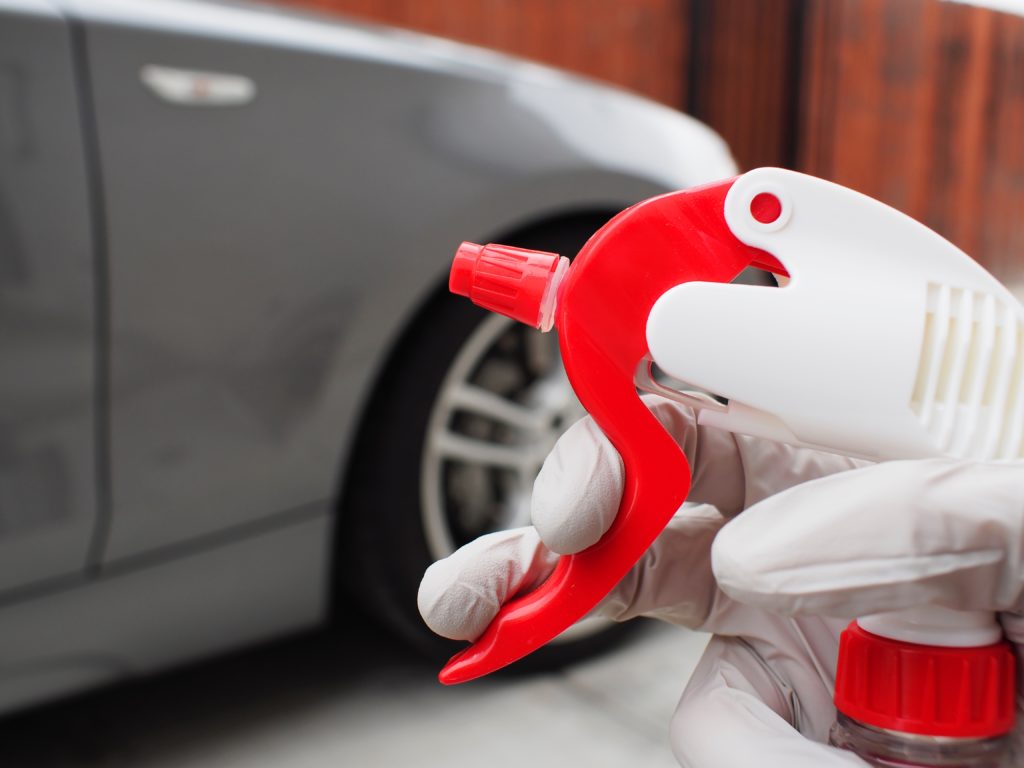
The next item on the agenda is to simply wait. The directions on the website and the back label of the bottle say to allow the product to dwell in place for roughly three to five minutes before agitation and rinsing.

Ever since these kinds of wheel cleaners came out, this has been one of my favorite steps in the car-washing process. Seeing the color of the wheel cleaner change as it interacts with the brake dust is uniquely satisfying. The smell of Griot’s Heavy-Duty Wheel Cleaner is another added bonus. See the pool of liquid accumulating beneath the tire? That rich purple-red is the now-spent cleaner, which has done its job effectively. Don’t worry; this stuff is pH-balanced, non-acidic, and non-caustic, and I’ve never had an issue with it staining concrete or a driveway, or damaging the wheel finish, even when left on longer than the instructions suggest.
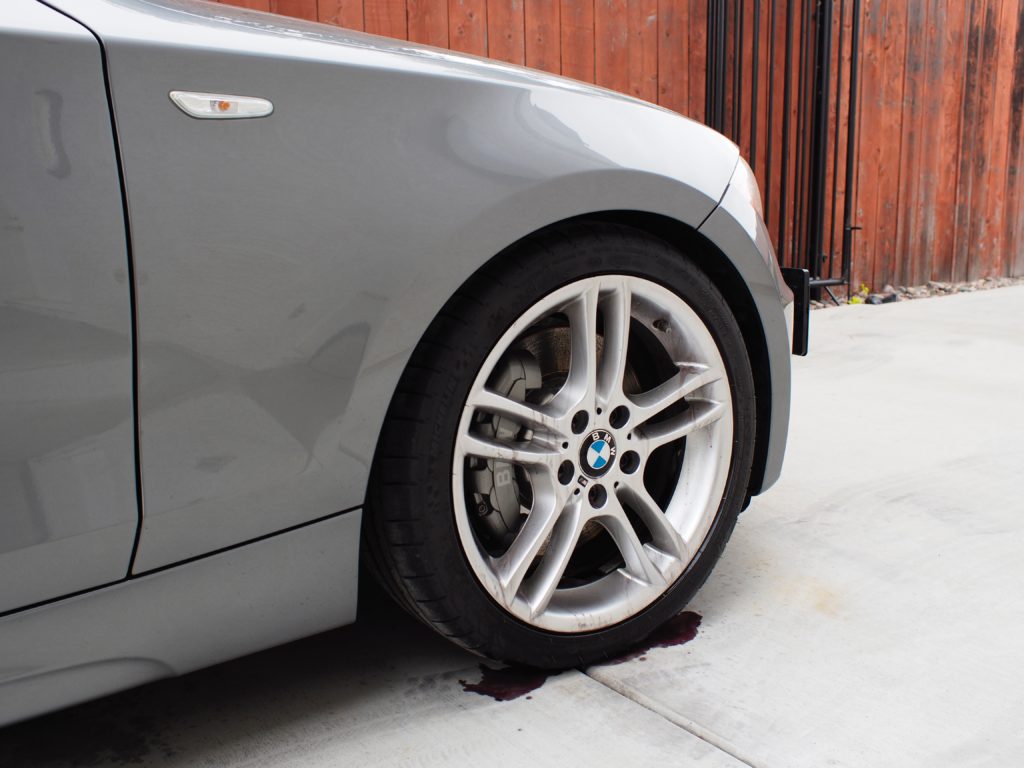
Of course, the process isn’t as simple as spraying the wheel cleaner, hosing it off with decent pressure, and walking away. It is still necessary to agitate areas of deeper coverage, along with attacking the crevices and other areas where dust likes to accumulate. Griot’s has an array of tools for this varied process, but my favorite is the Ergo Wave Foam Scrubber, which actually happens to have a multitude of uses. It’s got three finger holes, so you can always maintain the proper angle and pressure for different surfaces, and its cleaning ability is not limited to wheels; Griot’s says its safe and effective on vinyl, plastic, leather, rubber, paint, upholstery, carpet, and more. After using the machine-washable scrubber to agitate the brake dust and wheel cleaner, I’d love to order another one for leather cleaning and treatment.
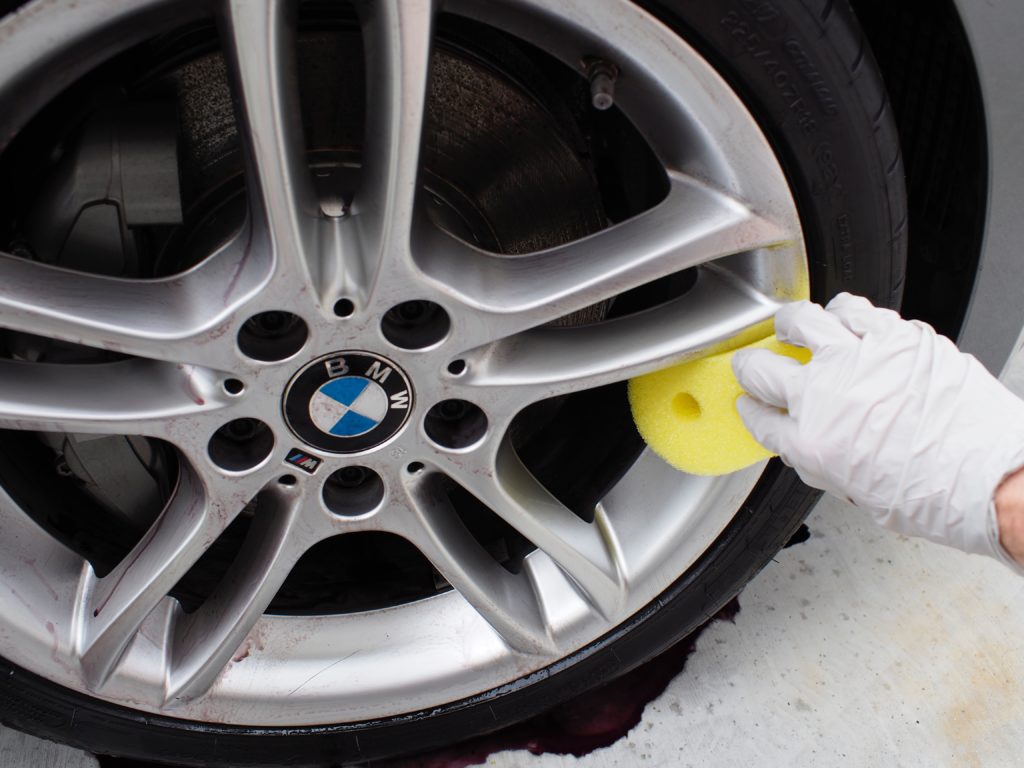
The foam scrubber doesn’t require much pressure to be effective, and easily picked up the grime that was sitting on my wheels. Check out what a single light pass yielded below.
I’ve learned a simple lesson while using Griot’s Garage products: the right tool, especially when it comes to car-care, makes all the difference. Whether it’s a drying towel, a spray-on detailer, or this highly versatile foam scrubber, for example, using the right product for the task at hand can often be a deciding factor in terms of the end result and satisfaction.

For some of the more difficult-to-reach areas, like where the rim meets the bead of the tire, Griot’s Boars’ Hair Detailing Brush comes in handy. The bristles are soft yet durable, and work well to reach into places that the foam scrubber or other wands will fall short. One example is where the spokes meet the rim itself; these corners already contain some pitting on my low-mileage 135i, so I feel it important to scrub the area, and then follow up with the detailing brush.

Although Griot’s also sells a dedicated wheel Lug Nut Cleaning Brush, when you search the term lug on Griot’s site, the Boars’ Hair unit also comes up. I found it very effective at cleaning out the crevices that are formed between the wheel and lug nuts. The brush is also among the only tools I have that can do a good job of cleaning out the surrounding vent holes. The brush also shines in places like the area around the valve stem, where the bristles allow for better coverage than a towel or foam pad.

I like Griot’s Microfiber Wheel Wands for the finishing step before it’s time to rinse. Instead of agitating and breaking up the dust, which in turn smears some of it around with the wheel cleaner, the microfiber of the wheel wands picks the dirt and grime up off the paint in a cleansing fashion, not unlike Griot’s other microfiber wash mitts and towels for paint. The two-piece set sold by Griot’s is really all you need, and allows for cleaning of commonly overlooked and missed areas such as the wheel-lug holes, brake calipers, and elsewhere. They are also highly effective on more complex wheels, such as a set of BBS basketweaves or Dayton wires.
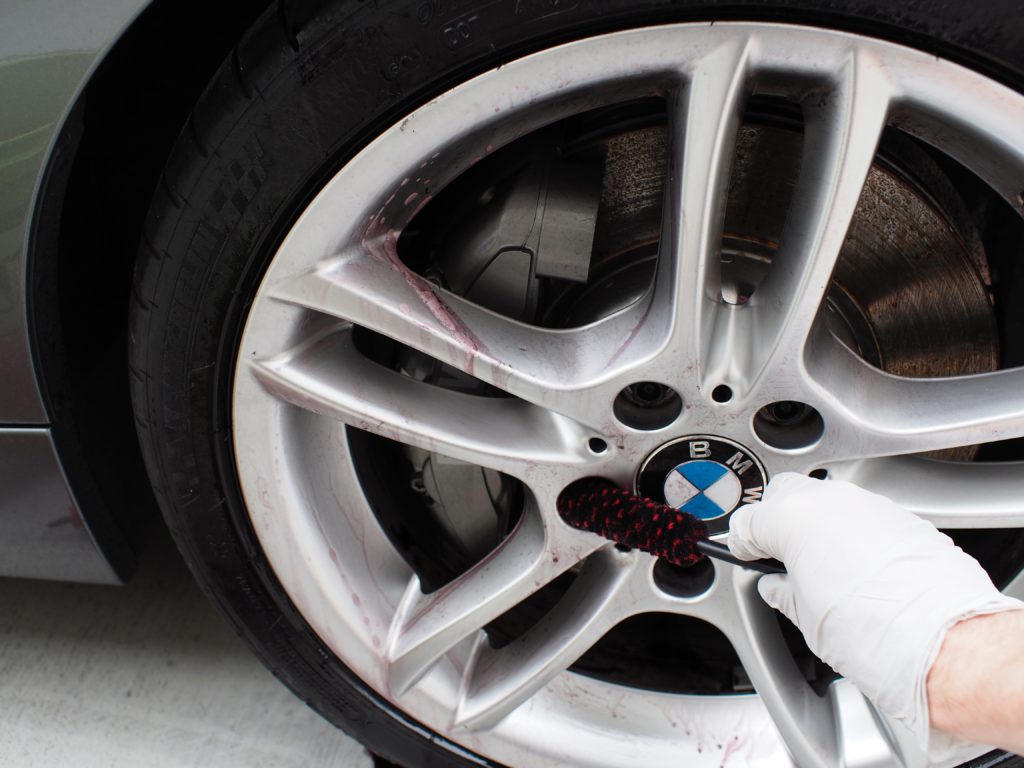
The larger of the two wands is also perfectly sized to address the narrow passage between the double spokes of my wheel design—Style 261, if you’re curious.

Now it’s time to rinse. I would say finally, but it took much longer to spell this process out than to actually execute it. Once the wheel cleaner and subsequent agitation have done their trick, I always follow up with a semi-high-pressure rinse with a wand. As noted in my previous car-care article, I like to use deionized water for rinsing. The top reason for this is that, in my area, tap water contains a high level of calcium and minerals, which can quickly turn into water spots and etching if left unattended.
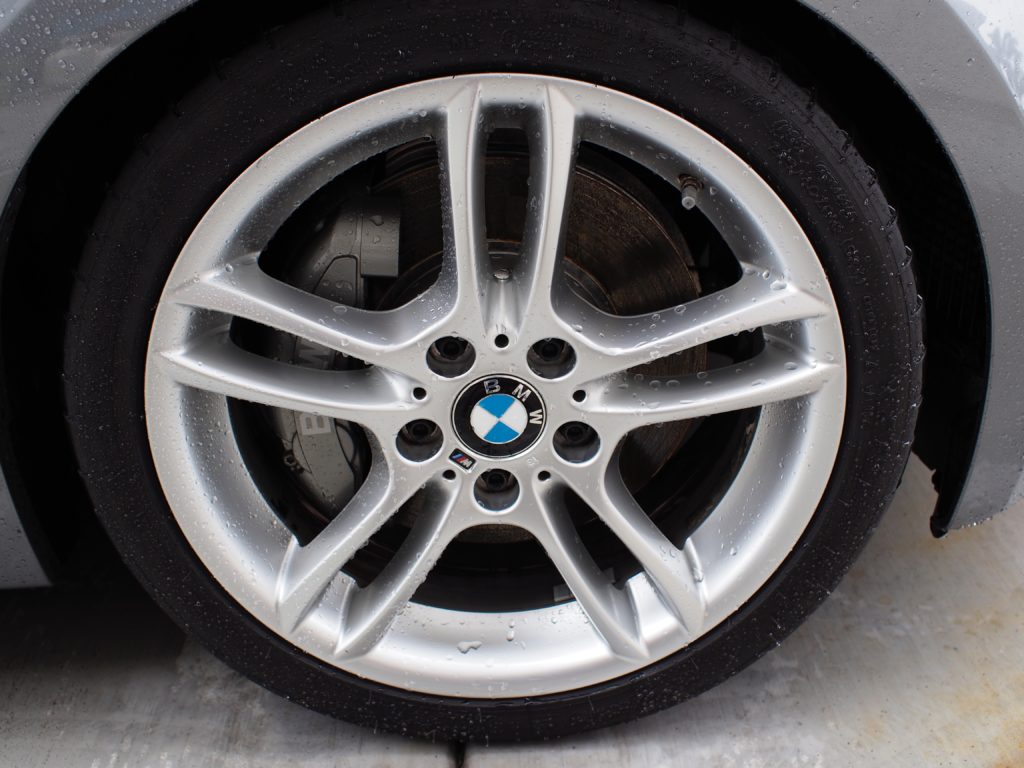
Never mind the collateral damage—water overspray on the fenders and rockers—cleaning the wheels is always my first step for a full car wash. Drying will occur later, once the rest of the car has been washed and pulled into the garage. Even in the wet state captured below, though, the finish of the wheel has a distinct presence that was dulled and hidden by brake dust before.
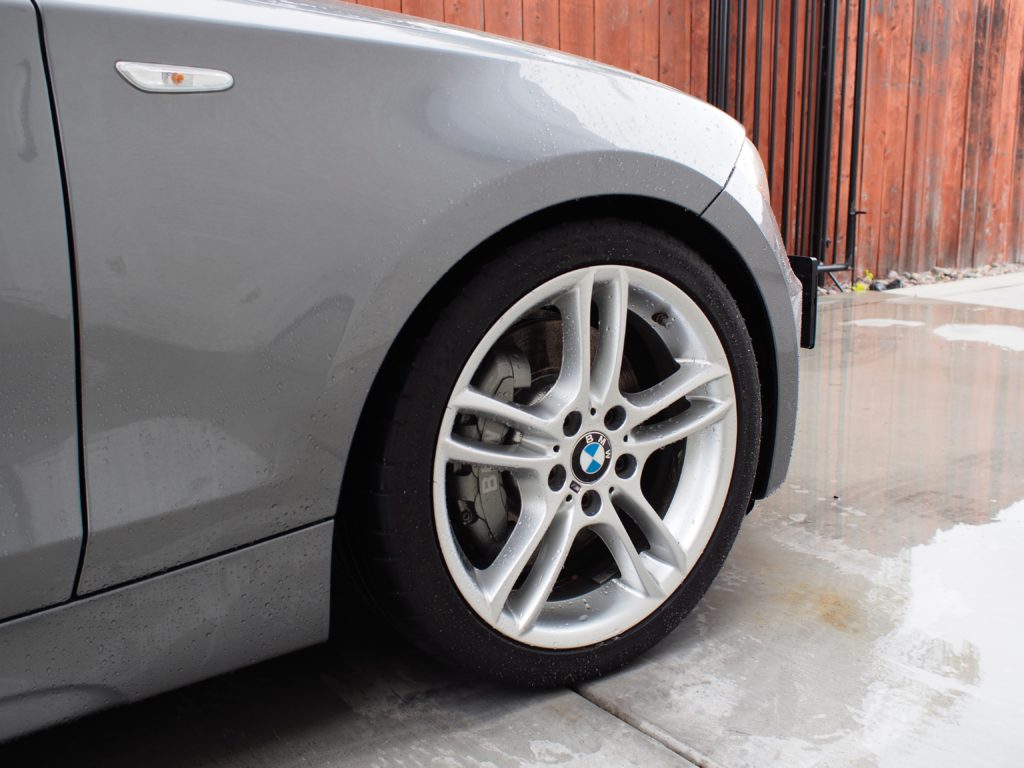
And here’s the finished state: My wheels aren’t perfect, but when they’re freshly cleaned, there’s something about the smooth finish of the metal and how it feels. Nonetheless, keen eyes will spot the large brake rotor housed by the wheel, which has already developed some light rust during the washing process. It only takes a drive down the street to get rid of the corrosion, but you can likely guess where it ends up: back in the wheels, thus initiating the never-ending cycle of BMW wheel washing.
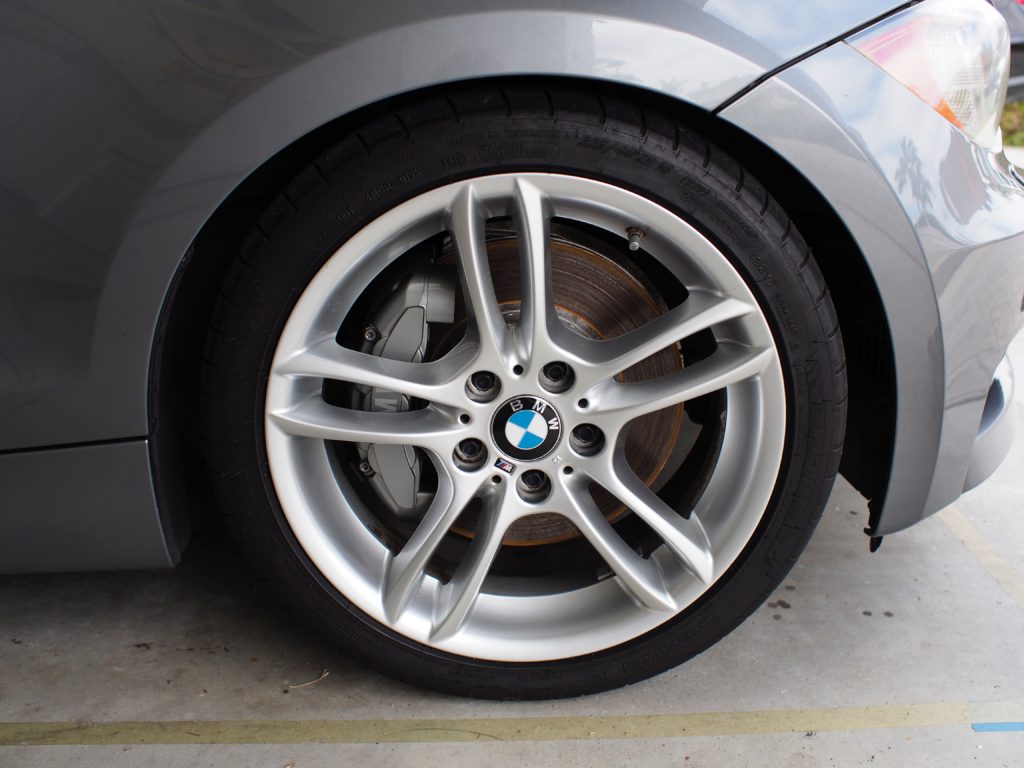
The angle below, in my opinion, exemplifies what I was talking about earlier. BMW’s Reflex Silver wheel paint has a uniquely eye-catching quality about it that really stands out when the finish is clean. Comparing the wheel finish to the freshly cleaned and waxed Space Grey Metallic paint on the panels communicates this as well, with the wheel showing its own reflective quality of the surroundings.
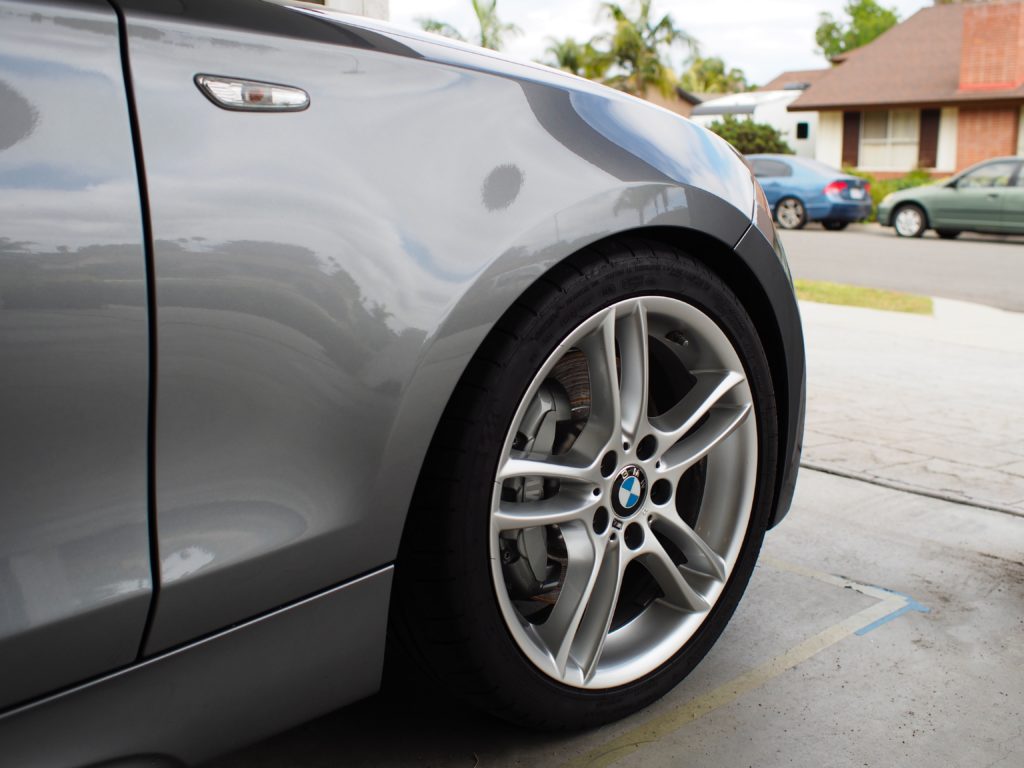
Whatever the car-care task on your agenda, Griot’s Garage has the products to make the process effective and fun. This is especially the case when it comes to their Heavy-Duty Wheel Cleaner, which has earned its place as a go-to product in my detailing arsenal. I’d like to thank Griot’s Garage for generously supplying these products and tools, although it should be noted that I have been using their excellent Heavy-Duty Wheel Cleaner long before I was ever sent a bottle to try.
Remember, BMW CCA members save 15% on all liquid car-care products from Griot’s Garage. Visit the BMW CCA website to find key codes and discount links.—Alex Tock
[Photos by Alex Tock.]

